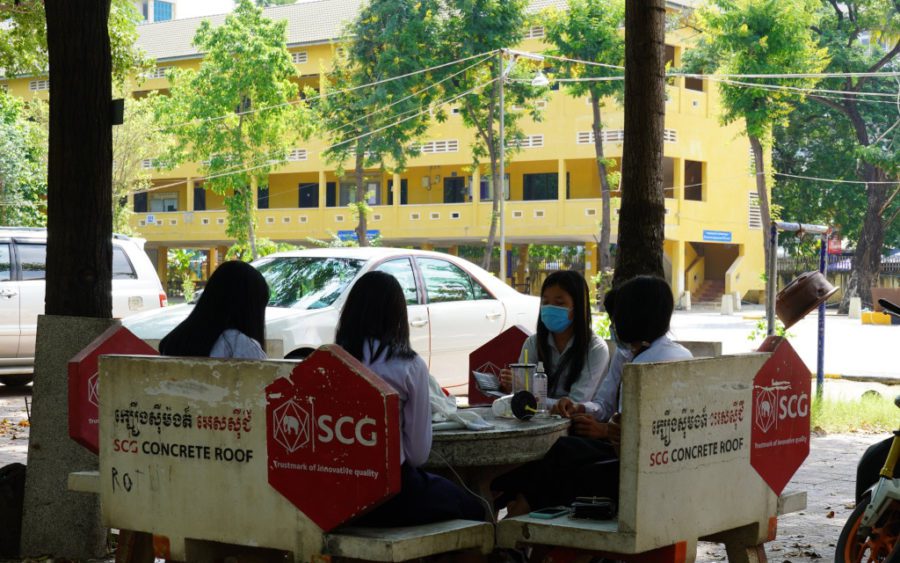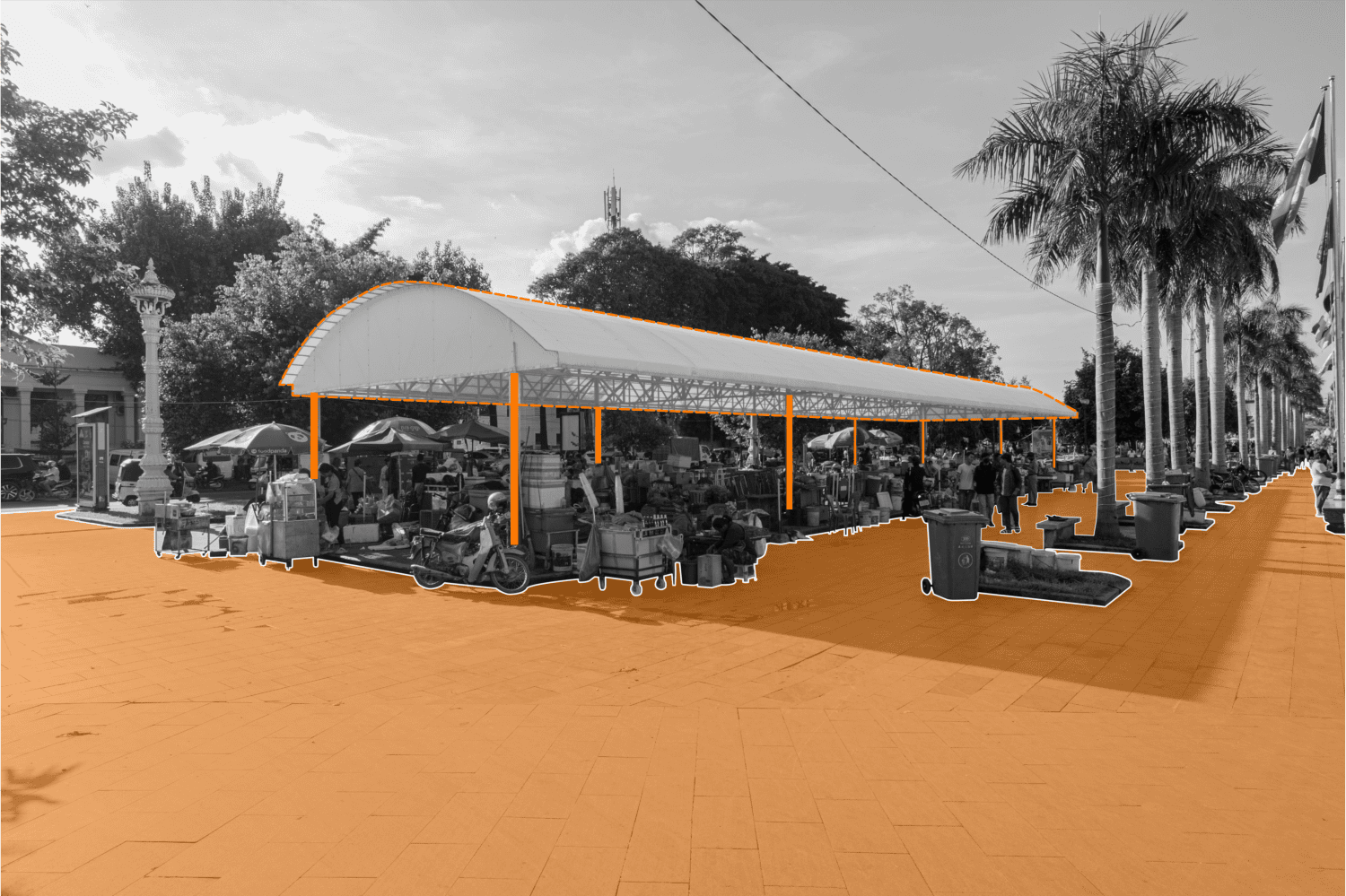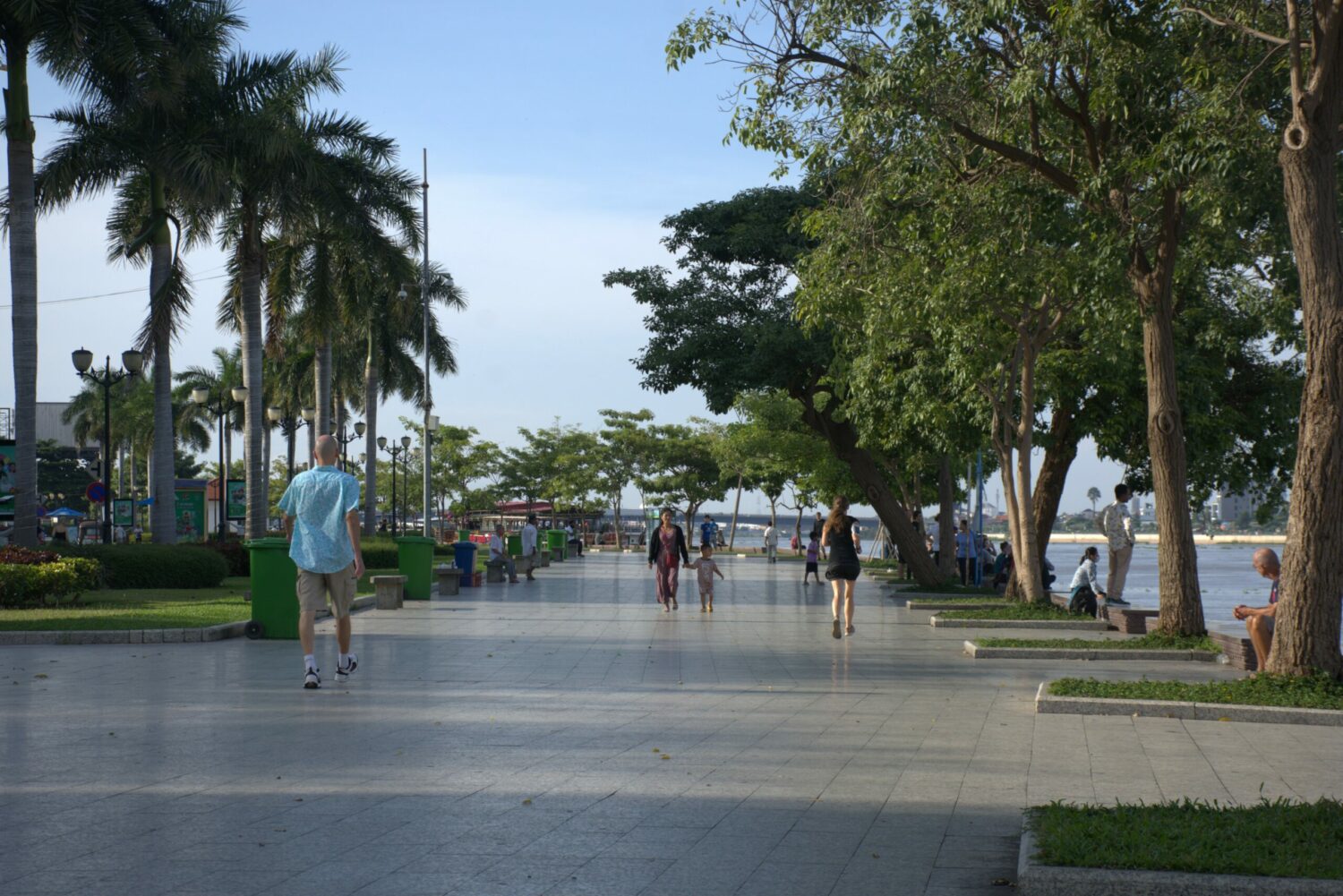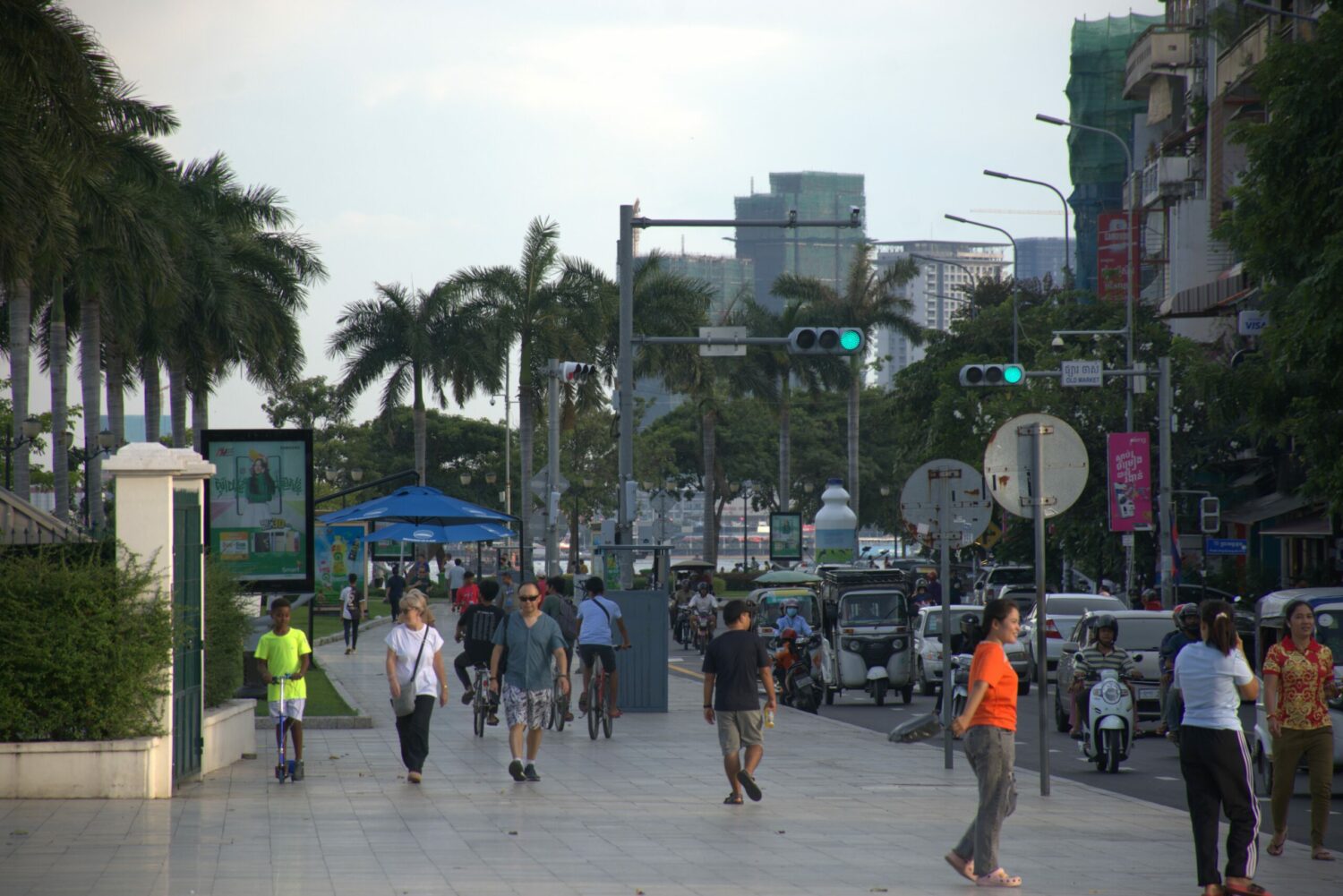A face to face, one-size-fits-all school system in which education is contained within classroom walls keeps learning out of reach for many students across rural underserved areas. Expediting a wall-less classroom system would allow Cambodia to level the playing field and equalize access to quality learning for all.
 Chea Dara is currently a program coordinator for the Young Researchers Program at Future Forum. He holds a Bachelor of Education in English (Honors) from the Royal University of Phnom Penh. He researches the future of education policy.
Chea Dara is currently a program coordinator for the Young Researchers Program at Future Forum. He holds a Bachelor of Education in English (Honors) from the Royal University of Phnom Penh. He researches the future of education policy.
Imagine this. It’s 9 a.m. and a young student called Chanvatey and her friends are sitting on bean bag chairs, on pitched floors, and at high tables by the veranda of a lecture hall. The rest of her peers — including poorer students who may need to help with their parents’ businesses and farming — are attending class via Zoom. The morning lesson is a group discussion facilitated by their teacher as well as a virtual field trip taken via Google Earth and AR technologies to Tonle Sap lake.
Chanvatey and her peers only come into this physical classroom when they need to interact and share ideas with each other or to attend a school and community event in person. Thanks to a digital library full of online books, educational resources, course content and reference materials, and a low-cost, locally-designed digital learning platform, they can learn, collaborate, share and sync data even when they’re on their families’ fishing boat or out in the rice field. The learning platform is a convenient means for teachers to connect with students and their families, track progress, and create micro lessons, educational videos, question and answer programs and other learning assessments and games.
Contrast this vision with the reality for Cambodian schooling today. The average school is made up of rows of physical buildings overcrowded with an average of 40 students per room sitting in tight rows of desks before one teacher lecturing from his or her place at the whiteboard.
The current reality of Cambodian schooling is also defined by a significant rural-urban educational divide. Even before the Covid-19 pandemic, rural students have long been struggling to catch up to their urban counterparts, battling persistent teacher shortages, lack of basic school and sanitary facilities, and low internet connectivity. The pandemic only worsened the pre-existing challenges, and has resulted in extensive learning losses, particularly among rural students.
To address the issues facing Cambodia’s education system, the Education Ministry’s strategy for 2019 through 2023 is based on building more physical schools, equipping them with adequate facilities, and deploying more teachers.
This strategy, however, doubles down on an industrial one-size-fits-all schooling formula which has proved outdated and ineffective for the Cambodian context. This is a formula that depends on Cambodian students being able to devote themselves to schooling at a set pace and at a unified place. Ultimately, this is a system that has been proven to only benefit those living near large schools, universities and urban centers, or students who have the means and support systems that allow them to devote fixed periods of time to study. It’s a system that has pushed students of low socioeconomic status and in underserved areas to the sidelines.
Reinventing the Wheel
Traditional schooling approaches are not the right fit for Cambodia’s most vulnerable students for a number of key reasons.
A traditional schooling approach is highly dependent on teacher delivery, which requires a huge investment in teacher retention. All the while, the ministry has dealt with persistent shortages of qualified teachers in rural provinces given the high annual attrition rates.
Aside from this, the traditional approach requires the construction and maintenance of physical school buildings. A physical school building that can accommodate around 75 to 200 students costs an average of $40,000-$70,000 to build. This is not to mention ongoing maintenance costs to keep school building, furniture and equipment in best shape for continuous operation.
Organizing learning in a classroom also creates a rigid teacher-centered environment that encourages the use of a unified curriculum and memory-based tests, and overlooks student learning differences, including students with learning disabilities. Teacher-centered classrooms are also prone to neglecting soft skills such as critical thinking, reflective thinking, problem-solving and collaboration because it gives students less freedom to move around the room, participate in group discussions, foster interactions among peers and resolve conflicts on their own.
The rigidity of traditional schooling also means that when a family needs their son or daughter to earn an income and contribute to household finances — even temporarily — students are prone to drop out entirely rather than be able to continue with their education on their own timeline and at their own pace.
Cambodia must instead invest in transitioning its schooling approach to an open and distance-learning formula using information and communication technologies to develop a digital classroom that offers open and flexible access to learning opportunities. This can remove proximity and time barriers to learning.
Go Wall-Less
A 21st-century learning approach takes place through diverse, privatized and flexible arrangements aided with digital technologies. In the past, we might have had to build a physical school for a thousand students to learn. Now a single online learning platform can do that. Think of platforms like Skillshare, Khan Academy, Coursera and more. Through tools like these learners can navigate millions of quality learning materials, quizzes and tutorial videos regardless of time and location-based constraints.
Numerous countries are already investing in wall-less classroom concepts to address administrative and educational bottlenecks experienced in traditional face-to-face schooling.
To meet the needs of underserved students, Nepal’s Open Learning Exchange developed E-Pustakalaya, a free and open digital library to encourage independent reading and learning through research and inquiry. Its content is made available in Nepali, English and integrated Nepali Sign Language and includes interactive multimedia learning modules to offer students a fun and meaningful learning experience.
Another example, Kolibri, developed in California, is a digital learning platform that does not require students to always be connected to the internet. It enables devices to find and connect with each other, share content and sync data over local Wi-Fi networks, then use that data even when disconnected. It has served millions of out-of-school or disconnected learners with connectivity constraints in over 200 countries.
Studies evaluating the outcomes of these types of interventions in Guatemala, Cameroon, and India claim student improvements in academic performance, math skills, digital literacy skills, cognitive abilities and analytical and creative skills. One study on initiatives in sub-Saharan Africa asserted that, if scaled up, these projects could lead to economic benefits equivalent to $2 billion annually by 2025 as better-trained graduates join the workforce.
These are examples Cambodia can follow to invest in wall-less classrooms to accommodate self-paced and personalized learning so students can feel the joy of learning in a less structured way anytime, anywhere.
During Covid-19, some initiatives appeared in the country to support remote learning outside traditional school settings, but encountered great challenges in learning participation and motivation. Many saw setbacks in these online experiences and asked for a return to schools. But wall-less classrooms are not about simply transferring traditional teaching to online platforms like Zoom or Google Meet. It is not teachers lecturing excessively in front of a camera and students listening and remaining silent mostly on Zoom, while some participants are hampered by poor internet connectivity.
A complete wall-less classroom needs a digital library and learning platform like Kolibri, where learning and community resources can be made available online and offline. It must go hand-in-hand with further discussions on how to teach students to be independent and self-learn on such platforms. Learners may need a physical learning space part-time for the times they need to see a teacher, have an in-person group discussion, plan a joint activity with a partner or other scenarios, then continue to self-learn at their own pace at home.
This change in educational structure could also mean that big traditional five-classroom school buildings are no longer necessary, as teachers facilitate fewer students on site at one time. The space required for students could be reduced by 50%, meaning a major cost reduction, which the ministry could further reinvest in digital learning alternatives.
The Education Ministry can work to build free and open digital library systems and use interactive learning platforms, especially targeted to students in underserved areas with a scarcity of school buildings, teachers, electricity and internet connectivity.
The key ingredients to these initiatives are learning devices and internet access. The ministry should introduce a voucher scheme for poor students and provide low-cost Android tablets and portable USB sticks. With tablets, these students can access locally-established learning content online and offline. In limited internet connectivity zones, students can make use of “sneakernet sharing” — copying or downloading open-source educational resources from a digital library and using USB sticks to distribute them to others.
A greater investment in internet connectivity nationwide is a long-term imperative for powering disconnected schools in underserved settings. The ministry can work with corporates and nonprofit partners to map hardest-to-connect schools’ real-time connectivity and develop financing programs. This could save on the government’s budget for unserved schools while attracting private investment in internet services and low-cost technologies such as desktop computers, Raspberry Pi computers, wireless routers, servers and solar panels.
Minimizing our reliance on conventional school buildings, traditional teacher-driven delivery and physical textbooks could mean reaching Cambodia’s most vulnerable students in transformative ways. Investing in this type of decentralized learning has the potential to give these students greater accessibility and flexibility in terms of when, where and how they learn, allowing for an education system that works based on what students need, instead of the other way around.
Chea Dara is currently a program coordinator for the Young Researchers Program at Future Forum. He holds a Bachelor of Education in English (Honors) from the Royal University of Phnom Penh. He researches the future of education policy.













